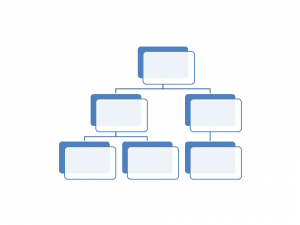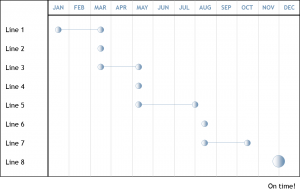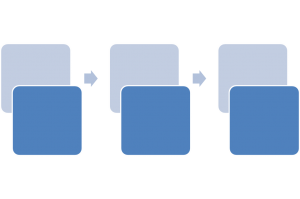Does your company use an organizational chart? Do you know your chain-of-command or where you fit it? Not every company uses or needs organizational charts (org charts). In a large company, seeing the chain-of-command can be useful when there are several departments and the levels of management can be unclear. Not only are these charts helpful for employees to see who they work for and where they fit into an organization, they provide a visual reporting route so the employee can see who else they may be able to go to if a situation arises. In a smaller company however, an org chart may not be necessary because there are not enough levels to merit employee alignment.
Let’s look some common org charts…

Top-Down Hierarchical – this org chart is commonly used to show rank by department. This is a great way to show each department’s positions from top to bottom. A drawback of this chart is that it can be overwhelming and employees at the bottom of the chart may feel slightly irrelevant in the organization.
 Horizontal Hierarchical – this org chart may be better utilized in smaller companies. It outlines the chain-of-command without adding other layers of reporting. A downside of this chart is that it can be unclear who reports to whom because it does omit layers of reporting.
Horizontal Hierarchical – this org chart may be better utilized in smaller companies. It outlines the chain-of-command without adding other layers of reporting. A downside of this chart is that it can be unclear who reports to whom because it does omit layers of reporting.
 Timeline – Org charts can have other purposes…they are not just limited to the company chain-of-command. They can be very useful at different levels and for planning and managing various developmental works, such as a specific team projects. Each team member should know who is working on what part of the project, who each individual reports to, and when their part of a project is due. A timeline org chart can be a good asset for keeping a project on time and on budget.
Timeline – Org charts can have other purposes…they are not just limited to the company chain-of-command. They can be very useful at different levels and for planning and managing various developmental works, such as a specific team projects. Each team member should know who is working on what part of the project, who each individual reports to, and when their part of a project is due. A timeline org chart can be a good asset for keeping a project on time and on budget.

Product/Inventory – Org charts can also be beneficial in warehousing or product inventory to keep track of products or services that are offered by the company. Employees can keep track of products that may be related or that can or should be used or purchased together.
So…not only can org charts show department levels and make planning easier, they can help determine if your departments are structurally sound. By using an org chart, you can see who is reporting to whom and see if your management to employee ratio is where it should be. It allows you to be able to visually see if you need to shift employees, or managers, into other positions in order to better control the work flow so that it’s a more efficient process. The org chart also allows managers to see if there are weaknesses in their area. Org charts can be used to determine if employees are producing at the expected levels and whether or not they are qualified for their position on the chart….and to see what positions need to be filled and at what level. It also provides a way for employees to view the possibilities of promotions. And, allowing employees to see a visual chart of positions and processes, allows for open dialogue that could lead to a better, more effective way of using personnel and designing processes.
When creating an org chart, keep your audience in mind. This will determine the levels you want to follow. If a person or position is really not in line or open to employees, don’t add them to the chart. For instance, an org chart for board members doesn’t need to show all lower level positions, but you might want to show different departments and who leads them. Consequently, the org chart for a department or process may not need to see all the way up to the board members. So while employees should be able to see who is in their immediate chain-of-command, entering only departments and not individuals above a certain level would be ok to show on a chart.
But…org charts are only beneficial if they are well maintained. Hence, a disadvantage of using org charts is that they need to be updated and this task can be tedious for a large company or a company that is always changing and growing. Not updating an org chart can lead to a breakdown in communication causing vital information to be disseminated to the wrong individuals, misinterpreted or lost altogether. Once you decide who will be on an org chart or what it’s be used for, make sure you take the time to update the chart to keep employees in the loop and your processes running smoothly.
Overall, org charts provide a means for employees to see where they belong, how different departments work together, and how they can be a part of company processes and goals to meet the business strategies and objectives.
EAF responds to hundreds of hotline calls and emails monthly. We would be happy to answer any interesting questions you may have too! Contacts us at [email protected] or 407.260.6556
Ready to Join? CLICK HERE to Join now and receive 10% off NEW Member Dues!
Use PROMO CODE: Join2018 on your Member Application.
Follow EAF on Social Media!
